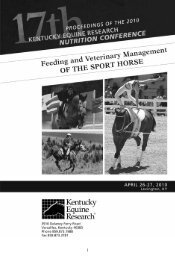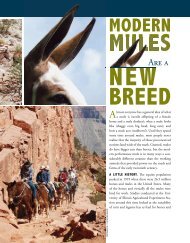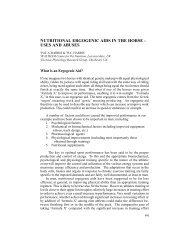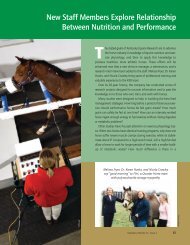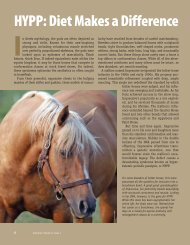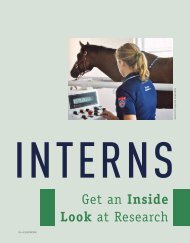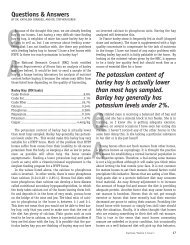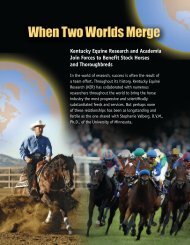Understanding Digestion in the Horse, A Comparative Approach
Understanding Digestion in the Horse, A Comparative Approach
Understanding Digestion in the Horse, A Comparative Approach
You also want an ePaper? Increase the reach of your titles
YUMPU automatically turns print PDFs into web optimized ePapers that Google loves.
Pregastric fermenters are <strong>the</strong>n subdivided <strong>in</strong>to rum<strong>in</strong>ants or nonrum<strong>in</strong>ants. Common rum<strong>in</strong>ants<br />
are cattle, sheep, goats, deer, antelope, and camels. These animals have highly<br />
developed digestive tracts that use fermentation to degrade feedstuffs. Large, multicompartment<br />
stomachs selectively sort and reta<strong>in</strong> plant fiber for extended periods of time.<br />
Digesta <strong>the</strong>n moves to <strong>the</strong> animal’s “true stomach,” hence <strong>the</strong> adjective “pregastric.”<br />
Nonrum<strong>in</strong>ants <strong>in</strong> this category <strong>in</strong>clude hamsters, voles, kangaroos, and hippopotamuses.<br />
H<strong>in</strong>dgut fermenters are also split <strong>in</strong>to two classifications accord<strong>in</strong>g to whe<strong>the</strong>r <strong>the</strong>y<br />
depend primarily on <strong>the</strong> cecum or colon for microbial digestion. Cecal fermenters <strong>in</strong>clude rabbits,<br />
gu<strong>in</strong>ea pigs, ch<strong>in</strong>chillas, and rats.<br />
Large nonrum<strong>in</strong>ant herbivores such as horses, rh<strong>in</strong>oceroses, gorillas, and elephants depend more<br />
on <strong>the</strong> colon for microbial fermentation. Omnivores such as pigs and man have sacculated colons<br />
where a good deal of digestion takes place. Carnivores such as cats and dogs have little or no cecal<br />
capacity and an unsacculated colon.<br />
Adaptations for Microbial Fermentation<br />
In order for microbial fermentation to be useful, animals must have digestive systems that can<br />
reta<strong>in</strong> digesta and microorganisms for a long period of time while simultaneously ma<strong>in</strong>ta<strong>in</strong><strong>in</strong>g an<br />
environment suitable for fermentation of plant material. The degree <strong>in</strong> which a particular species<br />
is able to use fermentation will depend primarily on three factors: (1) <strong>the</strong> total volume available<br />
for fermentation <strong>in</strong> <strong>the</strong> digestive tract, (2) <strong>the</strong> retention time of <strong>in</strong>gested material, and (3) <strong>the</strong><br />
makeup of <strong>the</strong> microbial population <strong>in</strong>habit<strong>in</strong>g <strong>the</strong> h<strong>in</strong>dgut.<br />
Volume available for fermentation. The importance of microbial fermentation as a means of digestion<br />
<strong>in</strong> various species can be demonstrated by <strong>the</strong> proportion of <strong>the</strong> digestive tract devoted to<br />
fermentation. Rum<strong>in</strong>ants typically allocate <strong>the</strong> largest proportion of <strong>the</strong>ir digestive tracts to fermentation.<br />
Nearly 75% of <strong>the</strong> bov<strong>in</strong>e digestive tract, for <strong>in</strong>stance, is suitable for support<strong>in</strong>g microbial<br />
fermentation. The vast majority of this fermentation capacity is <strong>in</strong> <strong>the</strong> reticulum and rumen, two<br />
compartments of <strong>the</strong> stomach. Nonrum<strong>in</strong>ant herbivores such as horses tend to dedicate a smaller<br />
proportion of <strong>the</strong>ir total digestive capacity to fermentation. Both rum<strong>in</strong>ant and nonrum<strong>in</strong>ant grazers<br />
such as horses and cows usually have more developed digestive tracts than selective herbivores like<br />
rabbits and hamsters.<br />
Omnivores vary greatly <strong>in</strong> <strong>the</strong>ir fermentation capacity. For example, pigs have a volum<strong>in</strong>ous<br />
h<strong>in</strong>dgut account<strong>in</strong>g for about 48% of <strong>the</strong>ir total digestive capacity, but humans devote only<br />
approximately 17% of <strong>the</strong>ir tracts to microbial fermentation. As mentioned previously, carnivores<br />
usually have unsacculated colons that represent a small proportion of total digestive capacity.<br />
Table 1 compares <strong>the</strong> fermentive capacities of specific organs <strong>in</strong> n<strong>in</strong>e species. Rum<strong>in</strong>ants (cattle<br />
and sheep) use more of <strong>the</strong>ir digestive tract for fermentation than horses.<br />
Retention time. The extent to which plant material is fermented depends on how long it is <strong>in</strong> contact<br />
with <strong>the</strong> microbes. Longer retention results <strong>in</strong> more complete digestion, but <strong>the</strong>re is a limit to<br />
<strong>the</strong> total amount of time <strong>the</strong> material can be subjected to fermentation before energy production<br />
becomes compromised. Herbivores such as horses depend to a large degree on volatile fatty acids<br />
(VFAs) as a source of dietary energy. These VFAs are by-products of microbial fermentation. If digesta<br />
is reta<strong>in</strong>ed too long <strong>in</strong> <strong>the</strong> fermentive organs, VFAs will be degraded by certa<strong>in</strong> anaerobic<br />
microorganisms, thus depriv<strong>in</strong>g horses of energy.<br />
As rum<strong>in</strong>ants become larger, mean retention time <strong>in</strong>creases. Buffaloes, which at maturity have a<br />
body weight of about 2200 pounds (1000 kg), have retention times of between 90 and 100 hours.<br />
Retention times longer than this would make animals susceptible to <strong>the</strong> aforementioned degradation.<br />
Equ<strong>in</strong>ews/Volume 10, Issue 3 7



